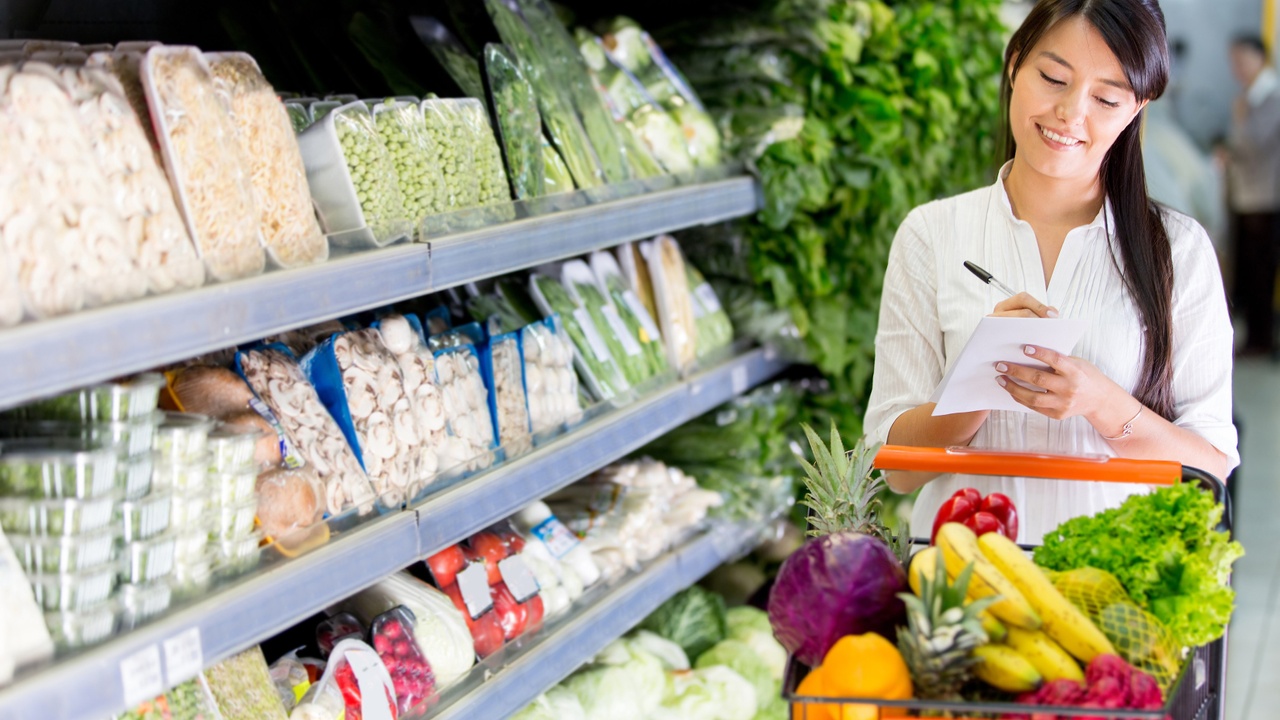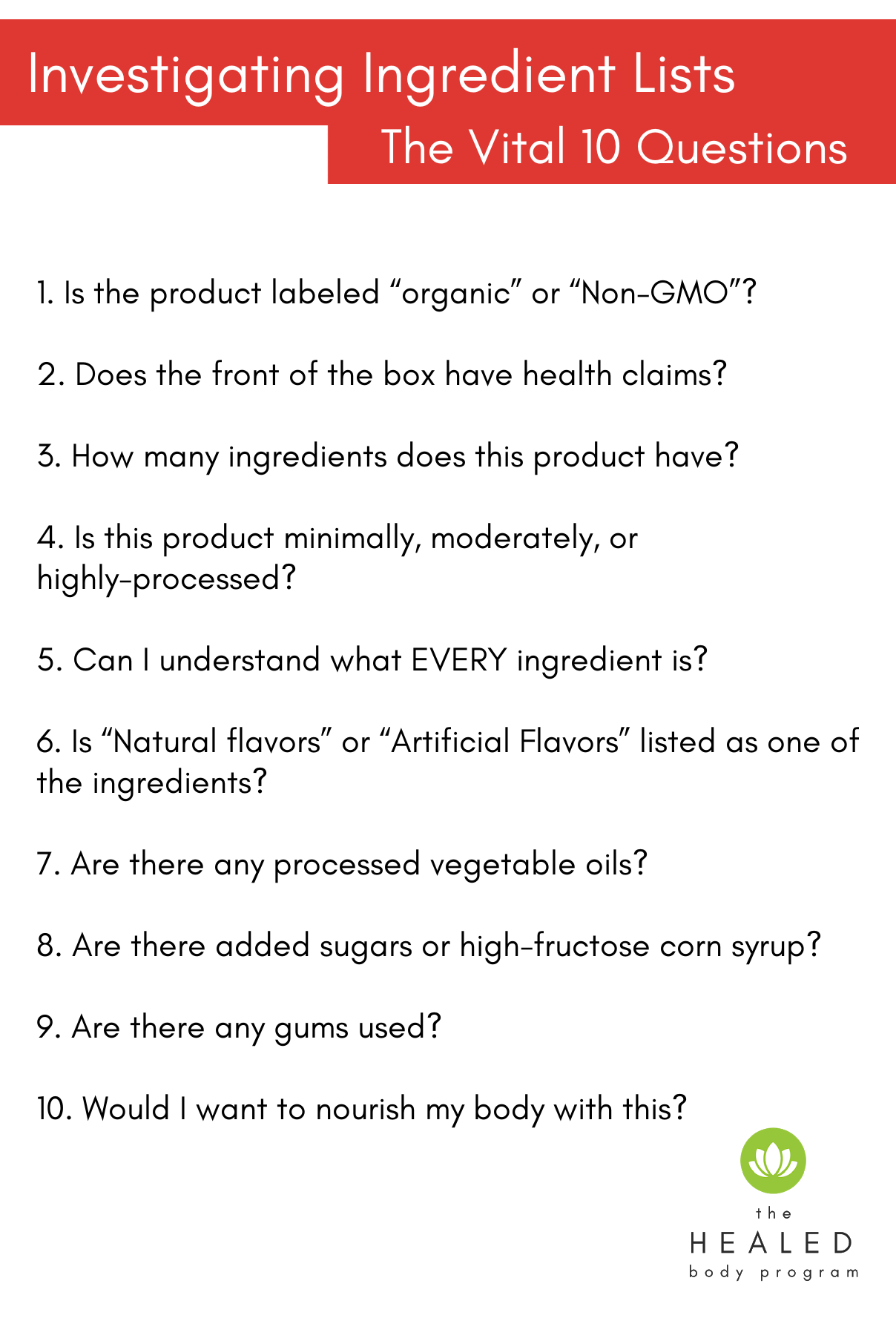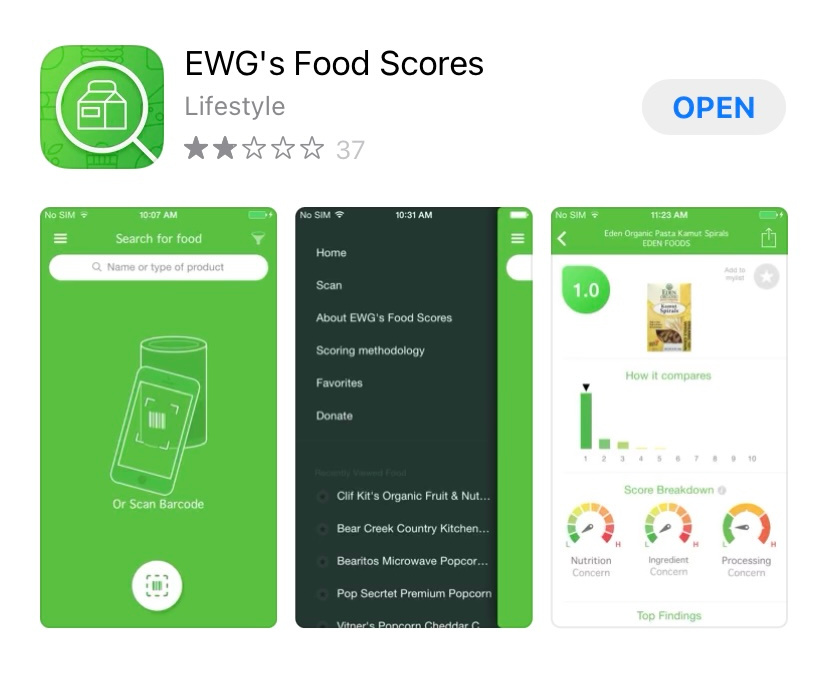How to read ingredient lists like a boss.

Grocery shopping has become a mind-game.
Label reading is confusing and most of us just don’t spend the time to really understand what is actually in our food.
Reading ingredient lists is a LIFE skill.
It takes a little time, patience, and practice to become an expert!
I highly recommend you investing time in reading every label on each product you buy.
Understanding exactly what you are ingesting and putting into your precious body is SO important!!!!
As you will see, it can be extremely difficult to know what food is simply by the ingredient list.
This is why it is paramount to discriminate what goes into your cart because those are exactly the foods that go into your body!
For example, you can buy peanut butter with tons of preservatives, additives and brain-starving processed oils or you can buy a jar with just peanuts and sea salt.
The choice is entirely up to you.
Being empowered and confident with label reading is one of the first steps in obtaining FOOD FREEDOM!
It takes investigation and a little practice to create the skills you need to navigate the grocery store and avoid chemically-laden foods.
The more we understand what to look for in labels, the healthier we and our families will be. If you want to eat and source clean food, it's important to train yourself on what to look out for!
Don't worry, this takes practice.
Again, remember we are taking baby steps! Let's dive into the overall steps when reading and deciphering ingredient lists:
- First and foremost, when buying any and all packaged foods READ EVERY LABEL.
- Focus on mainly sourcing organically certified products. This will help limit many chemical offenders such as artificial food dyes, "flavorings", and pesticides like Roundup.
- Ask yourself, how many ingredients does this product have? If it looks like a paragraph, just put it down.
The more ingredients added to a product the more preservatives and chemicals are added to keep that product shelf-stable.
Follow this rule of thumb: Don’t buy any processed foods with more than 10 ingredients. THEN follow the next step: - Make sure you understand what EVERY ingredient is. If you don’t know what an ingredient is, your body doesn’t either. Think chemical shit-storm that turns straight into fat.
- Don’t buy anything that boasts health claims such as low-fat, fat-free, healthy, natural, naturally flavored, low-carb, whole grains, skinny, sugar-free, light, gluten-free, lightly sweetened, cholesterol-free, etc.
Any packages with these claims deserve a higher level of investigation. - Pay attention to the order of ingredients as they are listed from the highest percentage to the lowest. If sugar is one of the first few ingredients you know that that product is primarily "added sugars"!
- Always look at serving size. Many "healthy" packaged foods have multiple servings in the package.
So when you read the label if it states 6 grams of sugar, you need to multiply that by the number of servings to really know how much sugar you'll be consuming if you eat the whole package!! - Avoid anything containing THESE highly processed vegetable oils.
- Corn
- Soybean
- Canola / Rapeseed
- Peanut
- Sunflower
- Safflower
- Palm
- Cottonseed
- Grapeseed
- Margarine
- Shortening
- Anything hydrogenated
Even if organic… it’s a pass. Think brain starving fat. These oils are highly processed with toxic solvents.
- Read the sugar content and list to see if there any added sugars.
- Sugar is sneaky and has 61 names, including..
- High Fructose Corn Syrup
- Anything with an “ose” at the end is disguised sugar.
Think chemicals that create fat and kill your brain, delivered by a can, jar, or box.
- Avoid anything with artificial sweeteners. Think death in a package.
A number of studies link artificial sweeteners commonly found in diet sodas, candy, and many ultra-processed foods to weight gain, obesity, cardiovascular disease, and diabetes.
Remember we are ridding our lives and bodies of all artificial foods and in place real, whole, clean foods!
BUT if you follow the following simple guideline, you don’t need to memorize all these ingredients to avoid:
Read every label, do not buy anything with more than 10 ingredients, and make sure you understand what every ingredient is.
Common Processed Foods Ingredients / Categories to be aware of:
Processed and manufactured foods are loaded with some of the most harmful ingredients in the modern food supply.
There are over 10,000 approved chemicals allowed in our food and a handful have been tested for safety.
The following goes over a few more ingredients and labeling, that deserve a deeper level of understanding.
The MAJOR Loop-hole “Natural Flavors”
I believe the most unassuming of ALL ingredients is “Natural Flavors”.
This term reflects just how little regulation there is in our food industry.
These two words can indicate there are more than 100 ingredients used under this umbrella term. It allows companies to hide ingredients they would rather you not know about. 10,000 chemicals allowed in our food can be hidden under this term.
These ingredients can include synthetic chemicals like the solvent propylene glycol, which can cause seizures and severe neurological symptoms, or the preservative BHT, a food preservative that is linked to cancer, as well as GMO-derived ingredients (unless organic or Non-GMO Project verified). These flavors can also include excitotoxins, like MSG that we discussed above, that causes you to feel addicted to the food after just a few bites!
I believe once you start reading every ingredient list, you'll discover just how much this loophole is used by companies who don't want you to know what's in the very product you are paying your hard-earned money for.
Steer clear of the "natural flavors" loophole and support companies that are transparent!
The highly addictive Sugar
Sugar is one of the most prevalent health hazards in our food system. Sugar is added to 74% of all packaged foods in the supermarket AND there are 56 common names for sugar. It is linked to SO many diseases and illnesses including but not limited to:
- Insomnia
- ADD/ADHD
- Breakouts & Skin irritation
- Tooth Decay
- Metabolic Syndrome - Obesity & Type 2 Diabetes
- Manic Depression
- Hypertension
- Anxiety
- Hypoglycemia
- Colon & Pancreatic Cancer
- Irritability
- Asthma
- Heart Disease
- Endocrine Problems
- Mood swings
- Personality changes
- The list goes on and on.
In 1900 the US consumed about 5 lbs. of sugar per person. In 2000, the US consumed about 150 lbs of sugar per person! 61 lbs. of that are from High Fructose Corn Syrup (HFCS)!
Sugar's excessive consumption has contributed to our diabetic pandemic. Common names to look out for are sucrose and high-fructose corn syrup, barley malt, dextrose, maltose, and rice syrup.
Just say no.
The most pervasive sweetener on the market is High Fructose Corn Syrup! It is the primary sweetener in soda, candy, and can be found in :
- yogurts
- salad dressings
- the majority of junk food
- bread
- canned fruit
- granola bars
- breakfast cereal
- sauce & condiments
- store-bought baked goods
- cookies crackers
- jams & jelly
- ice cream
- cereal bars
- "nutrition bars"
- coffee creamer
- energy drinks
- "sport" drinks
- and juice!
HFCS is derived from corn and is extremely detrimental to the body.
Corn
High fructose corn syrup is just one chemical made from this massively grown crop.
You may be surprised to discover that only 1% of corn grown in the U.S. is sweet corn, which is expensive to produce. The kind of corn that is so heavily consumed comes from field corn, a low-cost, genetically modified (GMO) commodity primarily used to produce ethanol gas and livestock feed.
The average American consumes 25 pounds of this corn a year. But wait you say, "I don't eat that much corn."
Well, you just might. Field corn is used to create a plethora of chemicals and "food" products that include:
- Corn flour, cornmeal. corn gluten, cornflakes, etc.
- Cornstarch, also listed on labels as starch or vegetable starch (See Healthier Food Swaps list)
- Corn oil
- Corn syrup or high fructose corn syrup
- Dextrins
- Maltodextrins
- Dextrose
- Fructose or crystalline fructose
- Hydrol
- Treacle
- Ethanol
- Free fatty acids
- Maize
- Zein
- Sorbitol
- Medications
- AND many more chemicals!
Any products from or animals fed field corn should be avoided as 36% of all corn grown is used as animal feed. This practice creates sick animals that rely on antibiotics and creates extremely low-quality meat for consumers.
The corn industry is highly unsustainable and responsible for many of the environmental concerns we have today.
Gums
Gums are common ingredients found in packaged and processed foods. They are used thickening agents to increase the viscosity of the solution or food and are usually used in small concentrations. Gums are known to affect gut flora and cause inflammation.
Check out my most recent blog post about Gums and how to avoid them.
The six most common gum additives in food are :
- Carrageenan
- Guar gum
- Xanthan Gum
- Locust Bean Gum
- Cellulose Gum
These gums are considered safe for occasional consumption by healthy persons with normal gut function. However, since the majority of people (estimated at 87%) have leaky gut.
It is best to avoid it altogether.
They are HUGE gut irritants and no one needs their gut more irritated!
One of the most helpful tool that is available to us is the EWG Food Scores Website.
You can use this App to help you investigate foods and food-like products to save you so much time and energy!
Here are the vital 10 questions you should ask with every label you read:

If you are new at reading labels, start slow.
It can be frustrating and downright overwhelming when you begin to really look at the foods you love and have always eaten to find out that they aren't "clean".
Finding replacements or slowly removing them from your daily diet is key.
Start with the food/products in your home first. This will help you identify the products you need to replace first so the process won't seem too overwhelming.
For example, if you have a favorite cracker that has 20 ingredients, including big offenders like high fructose corn syrup or high sugar content, canola oil (more on this in the Fats & Oils section), and GMO wheat... the next step is to find an organic option with fewer ingredients.
To help you clean up your food even more you can download My 5 Top Grocery Shopping Resources for FREE!
Just make one change at a time.
Trust me, you can do this, just remember this is a process.
Take little baby steps every day!
With love and gratitude,
Becky Wells
The Hippie Moms, LLC
www.thehippiemoms.com
The Hippie Moms Podcast
Were you forwarded this blog post or do you know someone who would love to receive this type of information in their inbox? Use this link to sign up!


